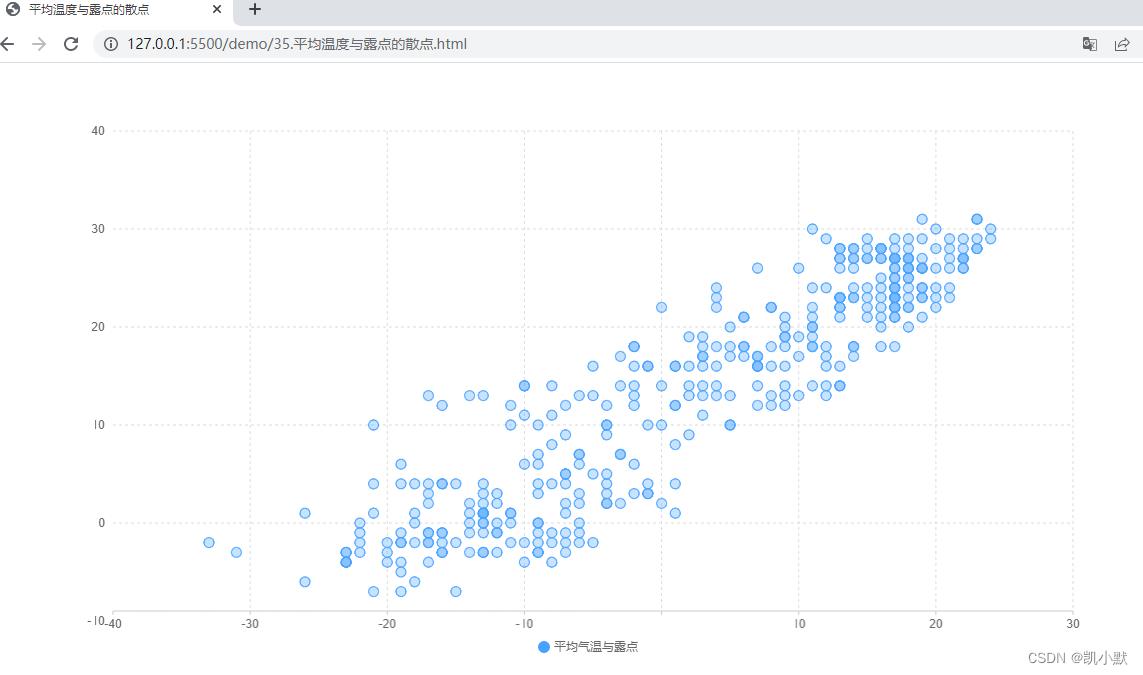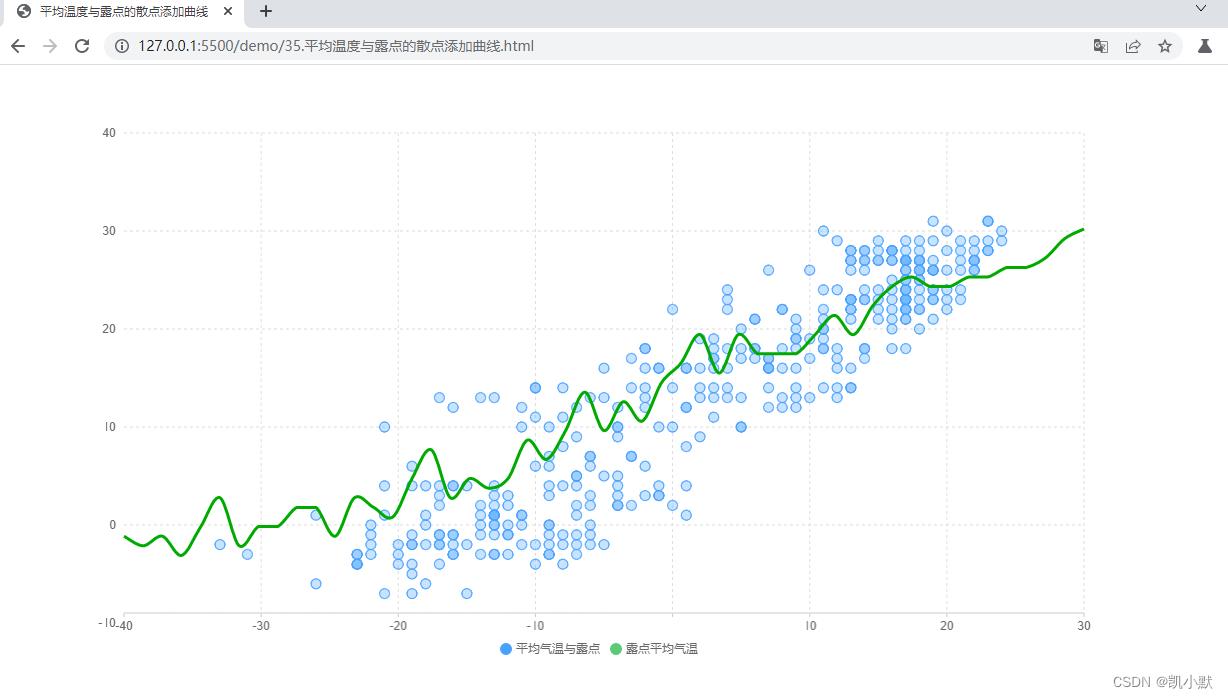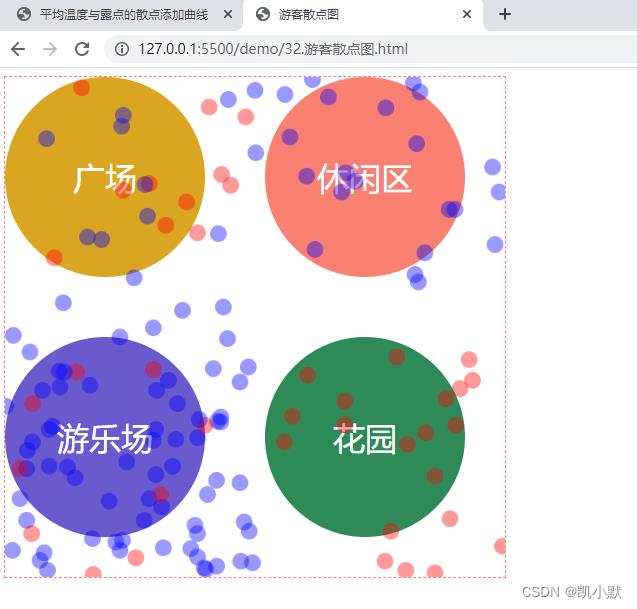设计篇35 # 如何让可视化设计更加清晰?
Posted 凯小默
tags:
篇首语:本文由小常识网(cha138.com)小编为大家整理,主要介绍了设计篇35 # 如何让可视化设计更加清晰?相关的知识,希望对你有一定的参考价值。
说明
【跟月影学可视化】学习笔记。
分清信息主次,建立视觉层次
用醒目的颜色突出显示数据,把被淡化的其他视觉元素当作背景。
比如:平均温度与露点的散点例子
<!DOCTYPE html>
<html lang="en">
<head>
<meta charset="UTF-8" />
<meta name="viewport" content="width=device-width, initial-scale=1.0" />
<title>平均温度与露点的散点</title>
</head>
<body>
<div id="app" style="width: 1200px; height: 600px"></div>
<script src="https://d3js.org/d3.v6.js"></script>
<script src="https://unpkg.com/spritejs/dist/spritejs.min.js"></script>
<script src="https://unpkg.com/@qcharts/core/dist/index.js"></script>
<script>
(async function ()
// 通过 fetch 读取 csv 的数据
const rawData = await (
await fetch("./data/beijing_2014.csv")
).text();
console.log(rawData);
// 使用 d3 的 csvParse 方法,将数据解析成 JSON 数组
const data = d3.csvParse(rawData);
const dataset = data.map(d =>
return
temperature: Number(d['Temperature(Celsius)(avg)']),
tdp: Number(d['Dew Point(Celsius)(avg)']),
category: '平均气温与露点'
);
const Chart, Scatter, Legend, Tooltip, Axis = qcharts;
// 创建图表(Chart)并传入数据
const chart = new Chart(
container: "#app",
);
let clientRect = bottom: 50 ;
chart.source(dataset,
row: "category",
value: "temperature",
text: "tdp",
);
// 创建横、纵两个坐标轴(Axis)、提示(ToolTip)和一个图例(Legend)
const scatter = new Scatter(
clientRect,
showGuideLine: true,
);
const toolTip = new Tooltip(
title: (data) => data.category,
formatter: (data) =>
return `温度:$data.valueC 露点:$data.tdp% `
);
const legend = new Legend();
const axisLeft = new Axis( orient: "left", clientRect )
.style("axis", false)
.style("scale", false);
const axisBottom = new Axis();
// 将图形、坐标轴、提示和图例都添加到图表上
chart.append([scatter, axisBottom, axisLeft, toolTip, legend]);
)();
</script>
</body>
</html>
下面就是一个有鲜明视觉层次感的图表:
- 使用比较鲜明的蓝色来突出图形
- 用比较淡的灰黑色来显示左侧和下方的坐标轴
- 用存在感最弱的辅助线背景来辅助用户更认真地阅读图表、理解数值

再此基础上可以添加曲线图来引导用户关注到平均气温与露点的正相关性特点
<!DOCTYPE html>
<html lang="en">
<head>
<meta charset="UTF-8" />
<meta name="viewport" content="width=device-width, initial-scale=1.0" />
<title>平均温度与露点的散点添加曲线</title>
</head>
<body>
<div id="app" style="width: 1200px; height: 600px"></div>
<script src="https://d3js.org/d3.v6.js"></script>
<script src="https://unpkg.com/spritejs/dist/spritejs.min.js"></script>
<script src="https://unpkg.com/@qcharts/core/dist/index.js"></script>
<script>
(async function ()
// 通过 fetch 读取 csv 的数据
const rawData = await (
await fetch("./data/beijing_2014.csv")
).text();
console.log(rawData);
// 使用 d3 的 csvParse 方法,将数据解析成 JSON 数组
const data = d3.csvParse(rawData);
const dataset = data.map((d) =>
return
temperature: Number(d["Temperature(Celsius)(avg)"]),
tdp: Number(d["Dew Point(Celsius)(avg)"]),
category: "平均气温与露点",
;
).sort((a, b) => a.tdp - b.tdp);
// 露点排序
let dataset2 = [...dataset]
// 对相同露点的温度进行分组
dataset2 = dataset2.reduce((a, b) =>
let curr = a[a.length - 1];
if (curr && curr.tdp === b.tdp)
curr.temperature.push(b.temperature);
else
a.push(
temperature: [b.temperature],
tdp: b.tdp,
);
return a;
, []);
// 最后将露点平均温度计算出来
dataset2 = dataset2.map((d) =>
d.category = "露点平均气温";
d.temperature = Math.round(
d.temperature.reduce((a, b) => a + b) /
d.temperature.length
);
return d;
);
console.log("最后将露点平均温度计算出来--->", dataset2)
const Chart, Scatter, Line, Legend, Tooltip, Axis = qcharts;
// 创建图表(Chart)并传入数据
const chart = new Chart(
container: "#app",
);
let clientRect = bottom: 50 ;
chart.source([...dataset, ...dataset2],
row: "category",
value: "temperature",
text: "tdp",
);
const ds = chart.dataset;
const d1 = ds.selectRows("平均气温与露点");
const d2 = ds.selectRows("露点平均气温");
// 散点图
const scatter = new Scatter(
clientRect,
showGuideLine: true,
).source(d1);
// 曲线图
const line = new Line().source(d2);
line.style("line", function (attrs, data, i)
return smooth: true, lineWidth: 3, strokeColor: "#0a0" ;
);
line.style("point", function (attrs)
return display: "none" ;
);
const toolTip = new Tooltip(
title: (data) => data.category,
formatter: (data) =>
return `温度:$data.valueC 露点:$data.tdp% `;
,
);
const legend = new Legend();
const axisLeft = new Axis( orient: "left", clientRect )
.style("axis", false)
.style("scale", false);
const axisBottom = new Axis();
// 将图形、坐标轴、提示和图例都添加到图表上
chart.append([scatter, line, axisBottom, axisLeft, toolTip, legend]);
)();
</script>
</body>
</html>
效果如下图,可以清晰的看到曲线描绘气温与平均露点的关系,这样层次分明的图表,非常有助于理解图表上的信息

选择合适图表,直观表达信息
之前 32 节里的公园游客散点图,在表达某个单组变量的分布状况的时候,不是很直观,可以使用饼图进行处理

<!DOCTYPE html>
<html lang="en">
<head>
<meta charset="UTF-8" />
<meta name="viewport" content="width=device-width, initial-scale=1.0" />
<title>游客饼图</title>
<style>
html, body
width: 100%;
height: 100%;
#container
width: 600px;
height: 600px;
display: flex;
flex-wrap: wrap;
justify-content: space-between;
#container > div
width: 300px;
height: 300px;
flex-shrink: 0;
</style>
</head>
<body>
<div id="container">
<div id="square"></div>
<div id="sections"></div>
<div id="garden"></div>
<div id="playground"></div>
</div>
<script src="https://unpkg.com/spritejs/dist/spritejs.min.js"></script>
<script src="https://unpkg.com/@qcharts/core@1.0.25/dist/index.js"></script>
<script>
const Scene, Sprite, Polyline, SpriteSvg = spritejs;
(async function ()
const data = await (await fetch("./data/park-people.json")).json();
console.log(data);
function count(d, dataset)
let place;
if (d.x < 300 && d.y < 300)
place = "square";
else if (d.x >= 300 && d.y < 300)
place = "sections";
else if (d.x >= 300 && d.y >= 300)
place = "garden";
else
place = "playground";
dataset[place] = dataset[place] || [
gender: "男游客",
people: 0,
,
gender: "女游客",
people: 0,
,
];
if (d.gender === "f")
dataset[place][0].people++;
else
dataset[place][1].people++;
return dataset;
function groupData(data)
const dataset = ;
for (let i = 0; i < data.length; i++)
const d = data[i];
if (d.time === 12)